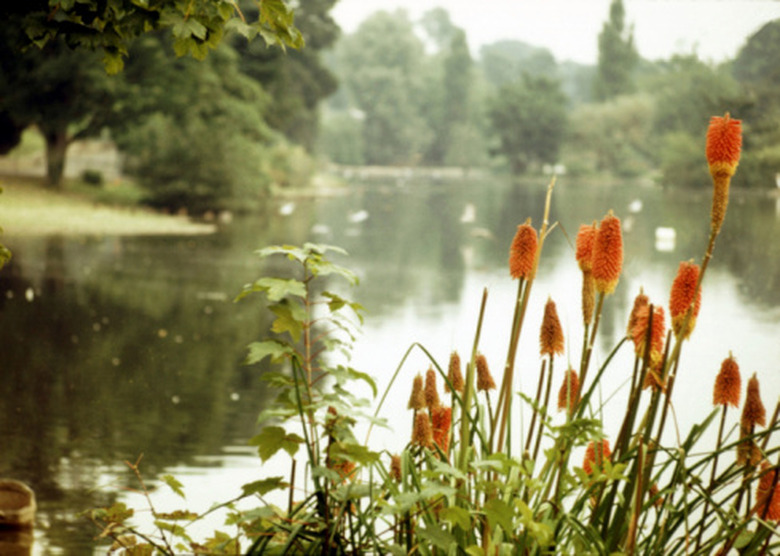The Ecosystem Of A Freshwater Pond
The classic green frog resting on a lily pad makes up just a tiny portion of the pond ecosystem. Freshwater ponds and lakes contain complex food webs and structures with multitudes of organisms. From the miniscule bacterium to the athletic and lithe river otter, pond ecosystems consist of many different organisms and interactions.
Basic Pond Ecosystem
Basic Pond Ecosystem
Most freshwater pond systems contain a similar structure with variations among species. Within the sediment on the bottom of a freshwater pond, you will find bacteria and other microorganisms. Growing in and around the sediment you'll find numerous plants and algae species. Invertebrates also roam throughout the sediment and the aquatic plants. Finally, you can find a wide range of vertebrate creatures, from fish and amphibians to wading birds.
The Pond Food Web
The Pond Food Web
The various pond organisms interact with one another in numerous ways within this ecosystem. Larvae, worms, insects and various invertebrates feed on the algae, bacteria, and detritus in the sediment. Larger invertebrates, as well as fish, birds and mammals, feed upon the many worms and insects present. Many of these "upper-level" food chain organisms also feed on each other in addition to the lower levels, such as wading birds feeding on fish.
Freshwater Pond Microorganisms
Freshwater Pond Microorganisms
Numerous types of microbes live within the muddy sediment at the bottom of a pond. These microorganisms break down dead and decaying matter and provide food to invertebrates.
Some examples of freshwater pond microorganisms include:
- Bacteria
- Algae
- Fungi
- Plankton
Freshwater Pond Plants
Freshwater Pond Plants
Many different types of plants or plantlike organisms live within pond ecosystems. Researchers recognize three groups of true aquatic plants, as well as algae, which are freshwater producers that resemble plants but are actually from the kingdom Protista.
Emergent plant types grow roots under the water but have portions of the plant that grow above the water's surface. Floating plants do not root to the bottom in any way and float freely in the water. Finally, submerged plants have roots in the sediment but do not typically grow above the water.
Some examples of freshwater pond plants include:
- Cattails (emergent)
- Bulrushes (emergent)
- Water hyacinth (floating)
- Duckweed (floating)
- Pondweed (submerged)
- Eelgrass (submerged)
Freshwater Pond Invertebrates
Freshwater Pond Invertebrates
Various invertebrates live within freshwater ponds. You can find a number of crustaceans, worms, leeches, mollusks, insects and much more. These creatures often feed on bacteria, algae and microorganisms.
Some examples of freshwater pond invertebrates include:
- Flatworms
- Roundworms
- Snails
- Clams
- Shrimp
- Dragonfly
- Mayfly
- Caddisfly
Freshwater Pond Vertebrates
Freshwater Pond Vertebrates
The vertebrates of pond ecosystems generally feed upon the invertebrates as well as each other. Numerous species of amphibians, fish, birds and mammals rely on freshwater pond systems for survival. A single pond organism, such as a fish, can feed on several types of insects, smaller fish species, worms and more.
Amphibians in Freshwater Ponds
Amphibians in Freshwater Ponds
An immense variety of amphibian species live within ponds. They typically feed upon invertebrates and provide food to larger vertebrates such as fish, birds and otters.
Some examples of freshwater pond amphibians include:
- Frogs
- Newts
- Salamanders
- Toads
Fish in Freshwater Ponds
Fish in Freshwater Ponds
Depending on where you live, you can find hundreds of different species of freshwater fish living in ponds and rivers. These creatures feed upon numerous insects, worms, larvae and other fish. They provide food themselves to birds, other fish and mammals.
Some examples of freshwater fish include:
- Gar
- Shad
- Trout
- Bluegill
- Pike
- Minnow
- Perch
- Bass
Birds in Freshwater Ponds
Birds in Freshwater Ponds
You're likely familiar with many aquatic birds. From the familiar white egret wading through the water in search of fish to the duck dipping beneath the surface to feed on plants, many different bird species rely on pond ecosystems.
Some examples of pond-dwelling birds include:
- Osprey
- Egret
- Heron
- Kingfisher
- Coot
- Cormorant
- Grebe
- Duck
- Goose
- Swan
- Loon
- Ibis
- Spoonbill
Mammals in Freshwater Ponds
Mammals in Freshwater Ponds
A handful of different mammals spend their time foraging in freshwater ponds. Beavers and muskrats build their homes in the water and feed upon vegetation. River otters race through the water after tasty fish to eat.
Some examples of pond-dwelling mammals include:
- Beavers
- River otters
- Muskrats
- Minks
Cite This Article
MLA
Zinni, Yasmin. "The Ecosystem Of A Freshwater Pond" sciencing.com, https://www.sciencing.com/the-ecosystem-of-a-freshwater-pond-13425235/. 30 September 2021.
APA
Zinni, Yasmin. (2021, September 30). The Ecosystem Of A Freshwater Pond. sciencing.com. Retrieved from https://www.sciencing.com/the-ecosystem-of-a-freshwater-pond-13425235/
Chicago
Zinni, Yasmin. The Ecosystem Of A Freshwater Pond last modified August 30, 2022. https://www.sciencing.com/the-ecosystem-of-a-freshwater-pond-13425235/
